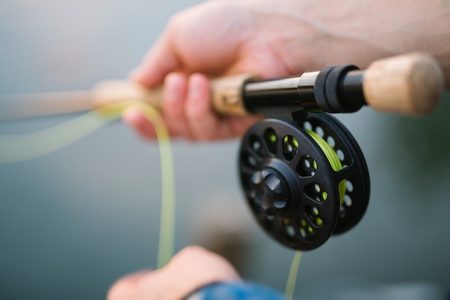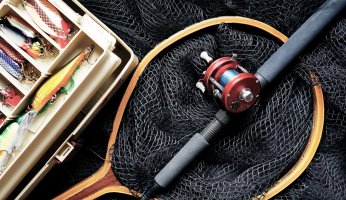Drift Fishing with a The Center Pin Reel
 Drift Fishing with a The Center Pin Reel
gearweare.net
Drift Fishing with a The Center Pin Reel
gearweare.net
Fly fishermen are no strangers to drift-fishing. In fact, it is a large part of fishing with a fly rod. When you are fishing with lures that do not have a lot of action, and you are relying on imitation and natural movements instead, it is a necessary skill to learn. The difficulty with drift-fishing with a fly rod is trying to detect a strike and preventing drag.
The concept of drift-fishing is simple. You cast upstream and allow the current to carry your lure downstream naturally, past any awaiting fish. This is the manner that most fish expect to see food approach them. As anyone who fly-fishes can tell you, however, it sounds easier than it is. One of the difficulties in presenting the lure naturally, and not causing any unnatural movements, is to try to prevent your line from creating a drag on your lure. Drag is when the line tightens and the lure begins moving irregularly from the current. Eventually, enough drag will cause your bait to swing in an arc at the end of the drift.
In fly fishing, this drag is corrected by “mending” the floating line which simply means lifting it off of the water with the rod and flipping the line so that there is no tension on the drifting fly. If you are spin cast fishing, however, your line does not float and this “mending” is not an option. This difference in lines is what makes fly rods a more effective choice for drift-fishing.

You may be wondering why a spincast angler would want to drift-fish, to begin with. It’s a fair question. After all, we think of ourselves more akin to snipers than carpet bombers. We try to place our lure exactly where we think the fish might be located or at least we try to work it through some specific area. In truth, there are many situations that a spincast angler might want to drift bait naturally. Steelhead fishing is just one of those situations. While a certain amount of drift can be accomplished with our own reels, by simply by opening the bail, sooner than later drag will rear its ugly head.
In Europe, somebody decided that what is needed is a new type of reel specifically designed to do what a fly reel and a spincast reel cannot. Allow line to come off of the spool as needed but in such a smooth manner that ‘drag-less’ drifts are extended to a nearly unlimited distance. They call this reel a Center Pin Reel. Physically, it looks like a very large fly reel, hanging under a long rod (usually a very long rod, 15′ is not uncommon). However, this is where the similarity ends.

Center Pin reels use monofilament line, not fly-line. Due to the fact that monofilament lines sink (and therefore cannot be “mended” to prevent drag), this long rod is necessary to keep as much line off of the water as possible. These rods are made specifically for Center Pin reels in order to perform this function.
It works something like this. Unlike a fly reel and more like a spincast reel, the reel is used to cast the line. The bait is cast upstream and, as it floats downstream, the angler keeps the rod tip pointed at the bait. Any required additional line is slowly and smoothly fed from the reel by the pull of the bait, thereby eliminating drag. There is no need to ‘shake’ line from the reel as you might with a fly rod or pull more line off of your reel like you would with a spincast reel.
Drift fishing with a Center Pin Reel utilizes a float or a bobber that is specifically designed for this type of fishing. The bobber keeps your bait at a constant depth, usually just off of the bottom of the river or stream, and it creates the force that the reel needs to release more line. Center Pins can be used to drift roe eggs, nightcrawlers, minnows, or flies and lures. The only requirement is a current. No current, no movement. For that reason, they are all but useless in lakes and ponds.
I think that most of us can agree that there are situations that this type of reel could come in very useful. Crappie fishing with minnows, Musky fishing with baitfish, etc. However, there is a learning curve to using one of these. It has to do with casting the line. There are one or two ‘techniques’ that need to be learned in order to prevent the reel from back-lashing and these techniques are a little unorthodox. The specific techniques for casting are beyond the scope of this article but they can be learned by watching a plethora of videos on the internet.
There is also a tendency for the line to begin to twist over time and this can cause tangles. This is usually resolved by cutting a few yards of the line from the spool after every three or four fishing trips. Do the reels work? I can tell you from personal observation that they are extremely effective. After several hours of standing in the same spot and drifting flies for steelhead, I decided I’d had enough and was packing up to go home. In the time it took me to get everything in my hands, a Center Pin angler stood in the exact same spot and caught two large fish in front of me!

The real question is probably this one. Are they really worth the effort to learn new techniques and the expense required to purchase an entirely new system? The reader will have to answer that for themselves but I suspect it would depend on where you live and what type of fishing you routinely do. If you are a frequent drift-angler, this may very well be the answer to your dreams. At the very least, it might be a new tool in your toolbox to be used when nothing else seems to work.













